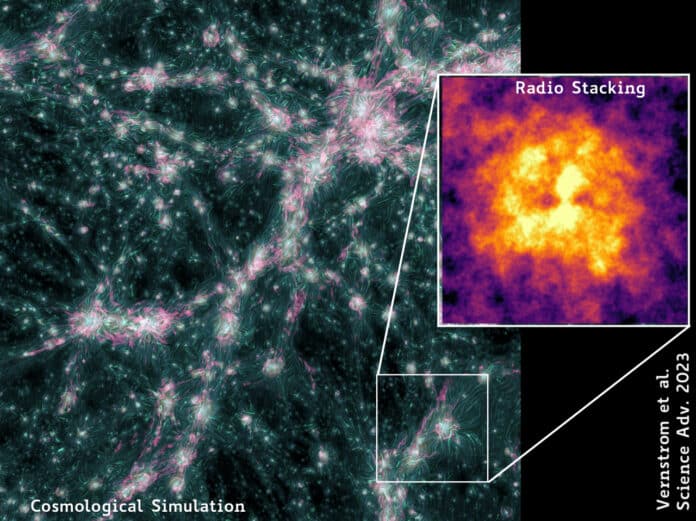The cosmic web wind around cosmic voids millions of lightyears across. Predicted by astrophysicists in the 1960s, computer modeling showed how this vast network truly looked in the 1980s.
Scientists have been able to map the Cosmic Web through observation over the past few decades, which opens up the possibility of finding answers to some of astronomy’s most important concerns.
How do magnetic fields behave on a cosmic scale? What role they play in both galactic and cosmic structure formation? These questions remain an area of particular interest.
We are learning more about these cosmic magnetic fields thanks to recent research, which was conducted by the International Centre for Radio Astronomy Research (ICRAR) in collaboration with the CSIRO, Australia’s national science agency.
Dr. Tessa Vernstrom, from The University of Western Australia‘s (UWA) node of ICRAR, is the lead author of the research and describes magnetism as a fundamental force in nature.
Dr. Vernstrom said, “Magnetic fields pervade the universe – from planets and stars to the largest spaces in-between galaxies.”
“However, many aspects of cosmic magnetism are not yet fully understood, especially at the scales seen in the cosmic web.”
“When matter merges in the universe, it produces a shockwave which accelerates particles, amplifying these intergalactic magnetic fields.”
The study recorded radio emissions from the cosmic web – the first observational evidence of strong shockwaves. This phenomenon had previously only been observed in the Universe’s largest galaxy clusters and was predicted to be the ‘signature’ of matter collisions throughout the cosmic web.
Dr. Vernstrom said, “These shockwaves give off radio emissions which should result in the cosmic web ‘glowing’ in the radio spectrum, but it had never really been conclusively detected due to how faint the signals are.”
Vernstrom chose polarised radio light as a signal type because it has less background “noise.” After all, the initial transmissions may have contained emissions from galaxies and other astronomical objects in addition to the shockwaves.
Dr. Vernstorm said, “As very few sources emit polarised radio light, our search was less prone to contamination, and we have been able to provide much stronger evidence that we are seeing emissions from the shockwaves in the largest structures in the universe, which helps to confirm our models for the growth of this large-scale structure.”
For the study, scientists used data and all-sky radio maps from the Global Magneto-Ionic Medium Survey, the Planck Legacy Archive, the Owens Valley Long Wavelength Array, and the Murchison Widefield Array, stacking the data over the known clusters and filaments in the cosmic web.
The stacking method helps to strengthen the faint signal above the image noise, which was then compared to advanced cosmological simulations generated through the Enzo Project. These simulations are the first to include predictions of the polarised radio light from the cosmic shockwaves observed as part of this research.
Journal Reference:
- Tessa Vernstrom, Jennifer West, et al. Polarized accretion shocks from the cosmic web. Sciences Advances. DOI: 10.1126/sciadv.ade7233
